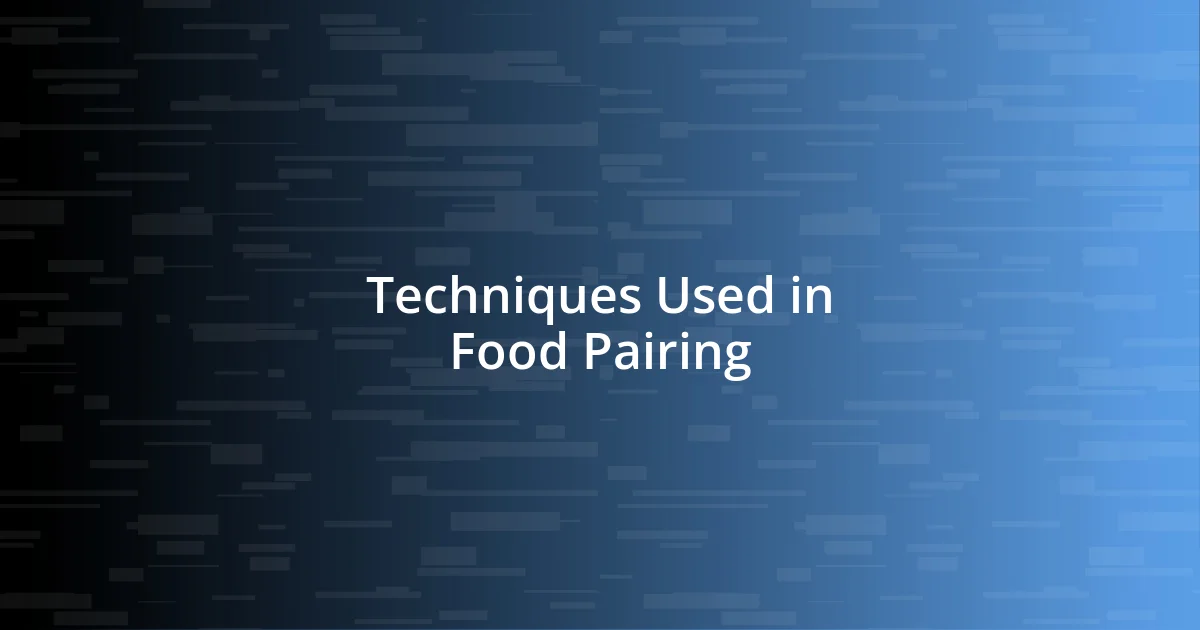Key takeaways:
- Food pairing workshops enhance culinary creativity and understanding of flavor profiles, transforming simple dishes into memorable experiences.
- Techniques like contrasting textures, flavor compounds, and cultural pairings foster exploration and innovation in cooking.
- Pairing food and drink not only elevates dining experiences but also encourages social interactions and meaningful conversations around the table.

Introduction to Food Pairing Workshops
Diving into the world of food pairing workshops opened my eyes to a whole new dimension of culinary experiences. I remember my first session vividly; the moment I tasted chocolate paired with a salty cheese, a burst of flavors exploded in my mouth, sparking a curiosity that hasn’t dimmed since. Have you ever wondered how certain ingredients can transform each other’s flavors so dramatically?
These workshops aren’t just about mixing different foods; they’re an exploration of complex taste profiles and sensory experiences. As we explored wine and cheese pairings, I was struck by how understanding the science behind flavors made the process feel like an art form. Isn’t it fascinating how something as simple as a pinch of salt can elevate a dish?
Moreover, the sense of community in these workshops is truly special. I recall bonding with fellow participants over our collective “aha!” moments when a pairing exceeded our expectations. Does it get much better than sharing joy and excitement over food? Every session felt like a delightful journey, fueling my passion for creative cooking.

Benefits of Food Pairing Skills
The benefits of food pairing skills extend far beyond the kitchen. I’ve found that being able to skillfully combine flavors can elevate not only my cooking but also the enjoyment of every meal shared with friends and family. There’s a deep satisfaction in seeing loved ones light up when they taste something unexpected yet harmonious. It truly feels like I’m sharing a piece of my culinary journey with them.
Here are some key benefits I’ve encountered through honing my food pairing skills:
- Enhanced Flavor Understanding: Learning how ingredients interact helps me create more balanced dishes.
- Increased Creativity: I feel encouraged to experiment with unconventional pairings, leading to delightful culinary surprises.
- Improved Social Interactions: Food becomes a conversation starter, strengthening connections with others who share a passion for cooking.
- Confidence in the Kitchen: I’ve developed a sense of pride and assurance in my ability to craft beautiful plates that tell a story through taste.
- Culinary Exploration: I’ve been able to explore global cuisines, understanding how different cultures approach flavor combinations.
Food pairing feels like a never-ending adventure, and I’m thrilled to continue this exploration with each dish I prepare.

Techniques Used in Food Pairing
The techniques used in food pairing are a fascinating blend of science and art. One key method is understanding flavor compounds; for instance, flavors can be categorized into basic sensations like sweet, salty, sour, bitter, and umami. I remember learning about umami’s role while tasting a dish where mushrooms and aged cheese beautifully complemented each other. It was a lightbulb moment, illustrating how certain ingredients can enhance those elusive tastes we often crave.
Another technique involves contrasting textures and temperatures. When I enjoyed a dish featuring warm roasted vegetables paired with crispy cold greens, it not only delighted my taste buds but also created a visually stimulating experience. It’s a reminder of how thoughtfully combining these elements can elevate an everyday dish into something memorable—it’s something I try to replicate in my own kitchen now.
Lastly, utilizing regional and cultural pairings can yield surprising and delightful results. I once experimented with an Indian dish by incorporating elements from Italian cuisine, bringing together spices and herbs in an unexpected harmony. The joy I felt when it turned out better than I had hoped was indescribable. This blending of traditions not only expands our culinary horizons but breathes new life into classic recipes, making meals an exciting adventure.
| Technique | Description |
|---|---|
| Flavor Compounds | Understanding how ingredients’ flavors interact, like balancing sweet and umami. |
| Contrasting Textures | Combining different textures and temperatures to enhance the dining experience. |
| Cultural Pairings | Blending culinary techniques and flavors from different cultures for unique dishes. |

Exploring Flavor Profiles in Pairing
Exploring flavor profiles in pairing is an exhilarating journey that changes how I perceive food. One time, during a workshop, we delved into the world of herbs. I discovered that pairing fresh basil with strawberries not only brightened my culinary repertoire but also awakened my senses. The combination of sweet, slightly tart strawberries with fragrant basil was like a conversation between two old friends. Have you ever tried such an unexpected pairing that just clicked?
The nuances of flavor profiles can be quite surprising. I remember a session where we focused on the balance between rich and acidic elements. Pairing a creamy burrata with a zesty lemon vinaigrette taught me the beauty of contrast. It’s amazing how one flavor can accentuate another in a way that transforms a simple dish into a culinary masterpiece. Who knew that the right balance could evoke such a strong emotional response?
Thinking about flavors in profiles has also made me a more thoughtful cook. For instance, I began experimenting with spice variations. One evening, I paired roasted sweet potatoes with a pinch of smoky paprika and a dash of cinnamon. The resulting flavor explosion was both comforting and creative. I realized that wielding spices is an art form, inviting us to paint with taste. Isn’t it fascinating how each dish tells its unique story through carefully chosen flavors?

Practical Applications in Daily Cooking
Incorporating food pairing techniques into daily cooking has been a game changer for me. For instance, I now intentionally experiment with contrasting textures. Just the other day, I made a simple salad with buttery avocados and crunchy radishes. The vibrant interplay not only satisfied my cravings but also made the meal visually appealing and exciting. Have you ever noticed how a delightful crunch can elevate a dish beyond its basic ingredients?
I’ve also learned to embrace the power of flavor compounds in my everyday meals. Remember that time I made a classic tomato sauce? Instead of sticking to just garlic and herbs, I decided to add a hint of cocoa powder. The depth it brought was incredible—transforming a familiar recipe into something intriguing. It’s these small tweaks that reawaken our love for cooking, isn’t it?
Cultural pairings have also inspired me to explore new culinary territories. Last week, I threw together a Mediterranean-inspired dish using leftover chickpeas and some curry spices. To my surprise, the blend not only worked beautifully, but it also rewarded me with a bright burst of flavors that felt both nostalgic and fresh at the same time. It struck me then how food can be a bridge across cultures—have you ever tried something that instantly took your taste buds on a global adventure?

Enhancing Dining Experiences with Pairing
Pairing food and drink can dramatically elevate dining experiences, transforming meals into memorable occasions. I recall a delightful dinner where we paired a hearty red wine with a perfectly grilled steak. As the wine’s rich notes mingled with the meat’s flavors, I felt a warmth that enveloped us, making each bite even more fulfilling. Have you ever experienced that moment when everything on your plate just feels right?
I’ve found that experimenting with unexpected pairings can also create sparks of joy at the table. One evening, I decided to serve a creamy blue cheese alongside a sweet fig jam. Each forkful unveiled a harmonious balance of flavors that had everyone buzzing with surprise and delight. It struck me how culinary pairing can enhance mood and camaraderie—doesn’t food have a peculiar way of bringing people closer together?
Moreover, I’ve noticed how pairing can guide conversations. When I served roasted vegetables drizzled with balsamic reduction next to a rich risotto, we found ourselves debating which flavor was our favorite. This sparked a lively discussion that lasted well into the evening, proving that a well-paired meal can turn an ordinary dinner into an unforgettable experience. Isn’t it incredible how food can stimulate not just our palates, but also our minds?

Conclusion and Future Learning Opportunities
As I reflect on my journey through food pairing workshops, I realize the real gift has been the endless possibilities for future exploration. Each session has opened my eyes to the science behind flavor combinations, sparking a desire to continue experimenting in my kitchen. Have you ever thought about how much more there is to discover with every dish you prepare?
Furthermore, I’ve discovered that learning doesn’t stop at the workshops. I’m eager to dive into culinary books or online courses that delve deeper into the art of pairing. Just the other day, I stumbled upon a fascinating article about the chemistry of flavor affinities. I felt that spark of excitement knowing there’s a whole world waiting for me to uncover. What resources might you explore to elevate your cooking?
Looking ahead, I hope to attend more specialized workshops focused on international cuisines. The idea of learning how different cultures approach food pairing intrigues me; it’s like a passport to new flavors. Imagine sharing a meal infused with both Italian and Thai influences—doesn’t that just tantalize your taste buds? It’s in these opportunities that I see the potential for growth, both culinary and personal.














